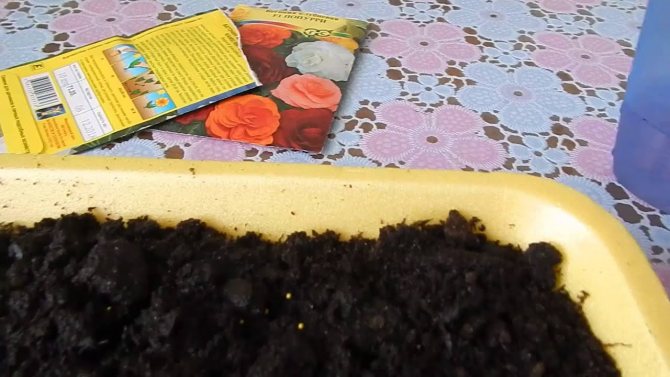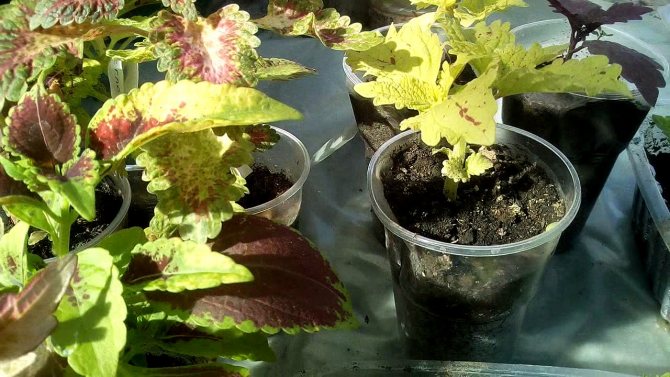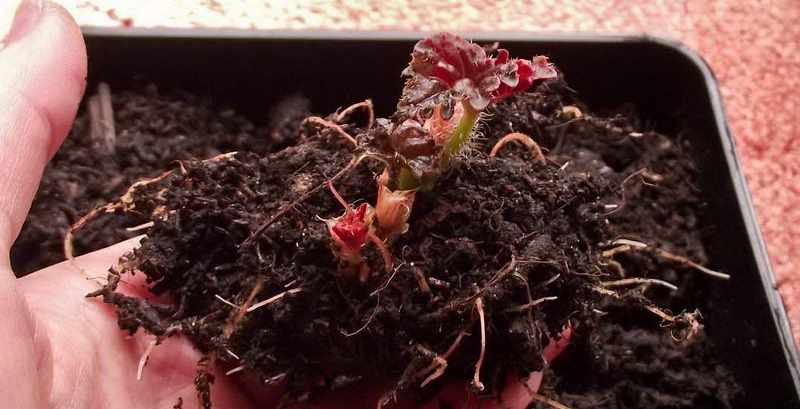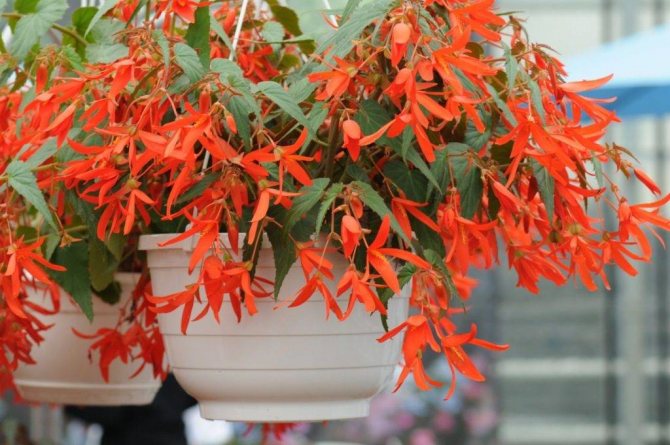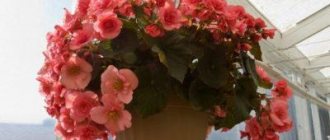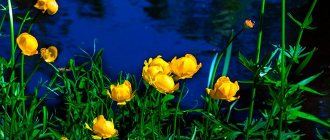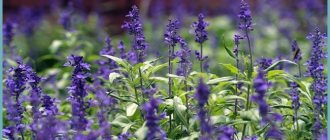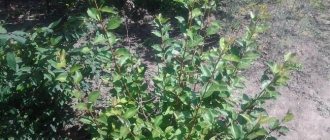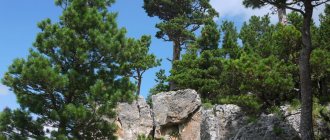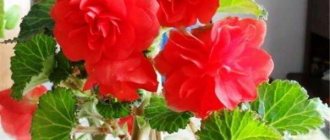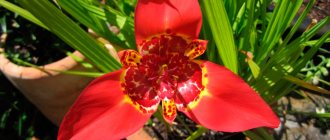Begonia is deservedly popular among amateur flower growers, because it pleases with its abundant and lush flowering almost to frost. How to plant ampel tuberous begonia, grow and care for it in order to get healthy luxuriously flowering plants, you can learn in detail from this article.

Begonia was introduced from South America to Europe in the 19th century. There are 3 types of begonias: tuberous, leafy and bushy.
- Tuberous begonia is usually grown in outdoor flower gardens, but you can also plant them at home. This species is divided into 3 groups according to the size of the flowers: with large, medium and small flowers. A special place is occupied by ampelous begonia, its hanging double or semi-double flowers on rather long pedicels give the plant an additional decorative effect.
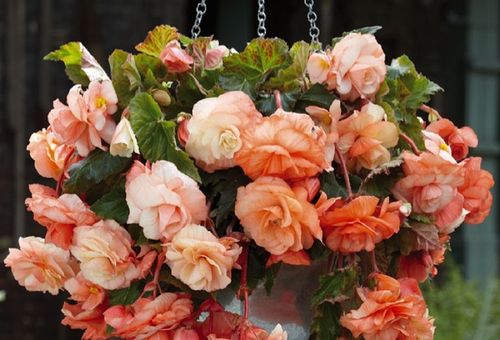

- Leaf begonias are used for indoor breeding. This is a species blooming with inconspicuous small flowers, the beauty of this species lies in the multi-colored leaves of a bizarre shape. Caring for them is less difficult than for tuberous ones.
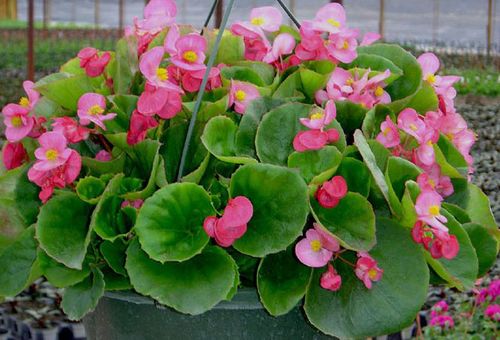

- Shrub begonias are more often grown at home, the plants bloom almost all year round. This species has decorative leaves and flowers.
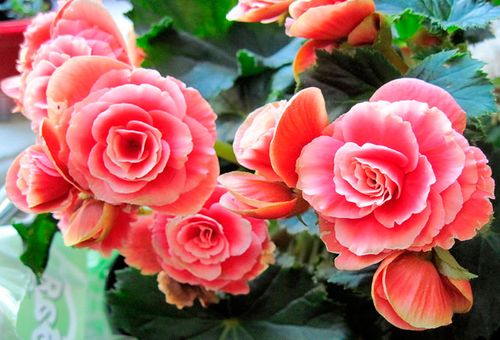

Shrub begonias
Ampelous begonia: general description
Ampelous begonia is a tuberous perennial plant with asymmetrical leaves and self-contained stems. The height, depending on the variety, can vary from 20 to 60 cm, the length of the leaves is no more than 20 cm. Begonia Belleconia salmon stands out among its relatives with long hanging shoots, their length can reach 1 m. It has an alternative name - drooping begonia.
The vast majority of species and varieties of plants have rich colors of buds, the diameter of the inflorescence is 5-10 cm.
Note! In the first years after planting, the plant may bloom with unattractive flowers, this is due to the fact that the flowers are female. After a certain time has passed, subject to all the rules of agricultural technology, men will soon appear.
The plant loves the hot and humid climate of the tropics and subtropics; in the wild, it is most often found in Asia, India, South America and Africa. For the first time in Europe, they learned about this plant at the end of the 17th century.
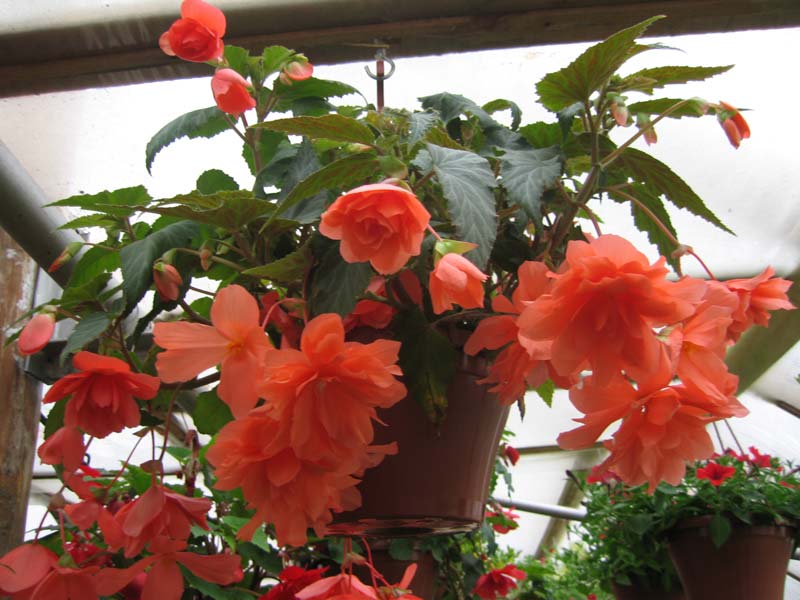

Tuberous ampelous begonia
As a rule, flowering begins in the middle of summer and lasts until the first frost, but this is possible only under favorable weather conditions and subject to the rules of agricultural technology. At home, you can contemplate flowering throughout the year.
Important! The lifespan of each flower is no more than 10 days, long flowering is ensured by the constant blooming of new flowers.
Types and varieties
Why begonia does not bloom
The most common varieties are:
- Bolivian ampel begonia is a variety, a characteristic feature of which is the aspiration of the shoots upward, but when their length reaches 30 cm, they attractively fall down, forming a floral multi-tiered cascade;
- Begonia Santa Cruz - growing it does not give the agronomist much trouble. Rapid development. The plant is sprawling, forms numerous shoots, the average length of which is 40 cm. Inflorescences are formed in red-orange and fuchsia colors.
- Begonia Bellekonia Chardonnay is a creeping, unpretentious culture, during flowering, numerous bright red flowers are formed, they are characterized by a bell-shaped form;
- Begonia Chardonnay - the variety is spreading, shoots up to 50 cm long are formed. It blooms from mid-summer until the first frost. Inflorescences are white, red, pink and orange.
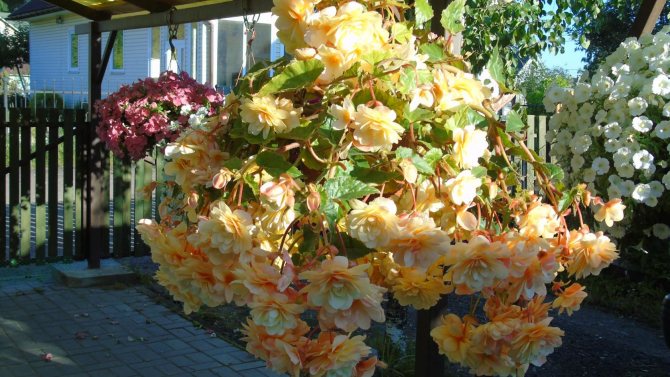

Begonia Chardonnay - Begonia Pink fung is a bushy tuberous plant, the height reaches no more than 20 cm. During flowering, a large number of pink inflorescences are formed. Subject to agrotechnical rules, it blooms magnificently and for a long time. The main feature of the variety is unpretentiousness in cultivation.
- Begonia Illumination is a powerful plant, the length of the shoots can reach up to 0.8 m. The flowers are large, their diameter can vary from 8 to 12 cm. An adult culture can occupy up to 1 meter of area in diameter. Grows willingly in shade and partial shade.
Ampelous begonia: planting and care at home
Petunia ampelous - description, planting and care
Ampelous begonia is a plant that, when optimal conditions are created for it, will willingly grow in open ground, as well as in hanging pots at home. Planting and caring for a crop does not require special knowledge, skills and effort.
Before planting, it is necessary to successfully select a site and prepare a soil mixture. The most suitable composition is turf, sand and leafy soil.
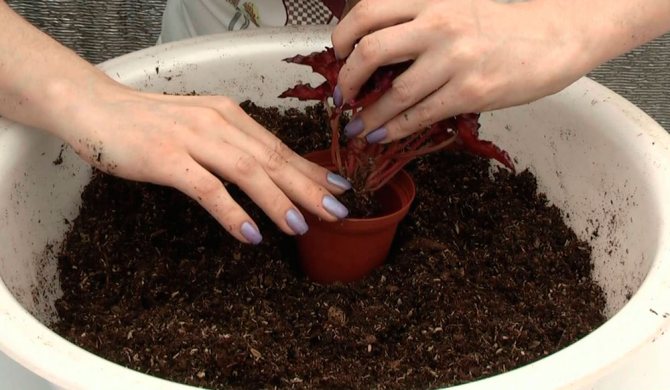

Soil mixture for begonia
A suitable time for planting seeds is December or January, therefore, it is recommended to prepare the soil mixture in advance, before the time when the ground is frozen. If the agronomist is deprived of the opportunity to independently prepare the substrate, you can purchase a ready-made one in the store.
If we are talking about reproduction not by seed, but by tuberous, then before planting, the cutting must be stored in a damp and warm place. The lower part of the tuber should lie on a warm, damp cloth, and then stand in a warm and well-lit place. Soon after small white roots have formed on the tubers, the plant can be transplanted.
In the container, you should first moisten the substrate abundantly, the tubers are planted with the part where the roots were formed. Sprinkle the tuber on all sides with soil, but not completely. The top of the planting material should be positioned on top until the first shoots appear.
Important! Freshly planted plants must be watered very carefully so that water does not fall on the tuber.
The plant is planted in a permanent place when the soil outside warms up enough. As a rule, this is the second or third decade of May. It must be borne in mind that the surface layer of the soil always dries quickly, so the tubers need to be properly deepened into the soil. The most suitable immersion depth is 1-2 cm. The earth must have a rich chemical composition and be fertile.
Note! For this plant, an important role is played not only by the composition of the soil, but also by its temperature. At low temperatures, the planting material stops absorbing moisture, which is fraught with drying out of begonias. The optimum soil temperature is not less than +18 degrees.
If one tuber is planted in each pot, then the diameter of the container should not exceed 15 cm. And also, it should not be deep, due to the fact that the plant has a superficial root system. Begonia does not like acidified soils, and in deep containers the lower layers of the substrate are always subjected to chemical processes. There must be drainage at the bottom of the container, which will allow excess moisture to be removed from the soil. The material from which the pot is made does not matter much, it is important that there are holes in the bottom, at least 5-6 pieces.
Begonia care
All varieties and varieties of plants like a lot of sunlight, but the light should be diffused so as not to cause burns. At home, it is better to choose a place where the rays of the morning and evening sun will not fall on the culture. If the culture is deficient in light, soon the leaves will begin to fade, wither and you will not see lush flowering for sure.


Begonia care
The optimum temperature for the full development of begonia is + 18-20 degrees. A slight decrease in temperature is acceptable. In summer, containers with a houseplant can be taken out into the street, balcony or veranda, but the place must be protected from wind, draft, rain and direct sunlight.
Diseases and pests
Ampel begonia has a fairly high resistance to disease. Most often it is affected by gray rot, powdery mildew and bacterial spotting. For the prevention and treatment of these diseases, it is necessary to irrigate plants with special fungicidal and insecticidal solutions. You can buy drugs in specialized departments.
Of the insects, the most troublesome are the whitefly, aphids, and the soft false shield. To combat them, special chemical preparations are also used; in case of severe damage, it is necessary to remove the affected plant fragments.
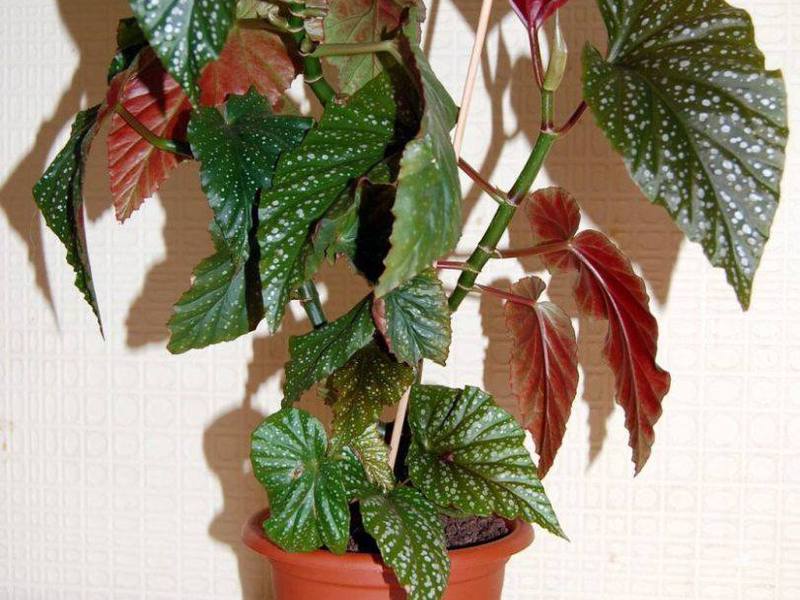

Diseases and pests
Growing problems
Bolivian begonia diseases are typical of this species. The plant, with improper care, weakens and becomes vulnerable. Disease with various rot, spotting, powdery mildew are the most common.
Gray rot
A sign of the manifestation of gray rot is brownish spots on the leaf plates of the plant. They affect an ever larger area, leading to the death of the plant. Rot can be caused by:
- excessive watering;
- waterlogging of leaf plates due to spraying;
- too frequent and excessive feeding.
As a result, a fungus develops, which can live in the soil for a long time even after the death of the plant. If the disease is detected at an early stage, then it is possible to apply treatment with fungicides. If the disease progresses, then the only way is to destroy the plant so that it does not become a source of disease for neighboring plants.
Powdery mildew
It is an airborne fungal disease. It is provoked by high humidity and temperature. The disease manifests itself in the form of whitish spots on the leaf plates of the plant. Decay of leaves and stems begins, which progresses rapidly and will certainly lead to the death of the flower, if the necessary measures are not taken in time. Systemic fungicides are used for treatment. In order not to provoke the development of the disease, you cannot overfeed the begonia with fertilizers.
If the flower is affected by different types of spotting, then treatment in this case is impossible. The plant will have to be destroyed so that it does not become a source of infection for neighboring flowers.
Pests also do not bypass begonia. You can find scale insects, nematodes, aphids, whiteflies. In these cases, special preparations are used to destroy pests.
Reproduction methods
Strawberry Ampelnaya
Ampel begonia can be propagated in several ways.
- tubers (when it comes to tuberous varieties);
- cuttings;
- seeds.
Seed method
The seed method of growing is perhaps the most troublesome and laborious, since the seeds are very small in size, easily dry out and rot. The soil is needed with a slightly acidic, close to neutral, reaction. To prepare the correct soil mixture, you need:
- sand (1 part);
- sheet land (4 parts);
- sod land (1 part).


Sand
The best time for sowing seedlings is the end of December-January, so you need to take care of the soil before the onset of frost.Before planting seeds, the soil in the planting boxes must be well moistened, and before filling the containers with earth, pour drainage at the bottom.
Spread the seeds evenly over the surface of the mixture and cover with foil or glass. After sowing, do not water - the water can drag the seeds under the ground and you can not wait for the germination.
In the room where the seedling box is located, it is necessary to maintain a temperature of +25 degrees. Seed germination time is 8-25 days.
Propagation by cuttings
The plant reproduces rapidly by stem cuttings. When propagated in this way, the plant retains all species and varietal characteristics. The optimal time for cutting cuttings is spring, shortly after the plant wakes up. Such sprouts quickly take root and grow actively. If necessary, you can graft ampelous begonia throughout the year.


Ampelous begonia propagates by stem cuttings
For propagation by cuttings, the stems of no more than 10 cm are cut off from the plant and placed in a container with clean water until the roots appear. As a rule, after one to two weeks, roots appear and the plant can be planted in a container with soil. For better survival, it is recommended to water the plant with warm water.
Dividing tubers
If more than seven shoots have formed on the tuber in winter, it can be divided into two parts. Therefore, subject to agrotechnical rules, two plants will grow.
A sharp and clean knife is used to divide the tuber. It is impossible to plant parts, it is necessary to allow the cut points to dry out a little, otherwise the likelihood of infection or pest damage significantly increases. The depth of the planting material in the soil should be no more than 2 cm.
Ampelous begonia is an unpretentious and at the same time attractive plant that even a novice agronomist can grow. Before purchasing seed, you must first familiarize yourself with all the features of growing a crop.
Seedling care
In about 12–20 days, seedlings will appear from the seeds. True, they are so tiny that many growers look at them with a magnifying glass. In this state, the pallet with seedlings is placed in the light, but not in the sun, at a slight slope. This is done so that all excess moisture rolls to one side. That improves the condition of the soil, prevents the development of diseases.
The temperature drops to 20-22 ° С and is maintained throughout the entire period of seedling growth.
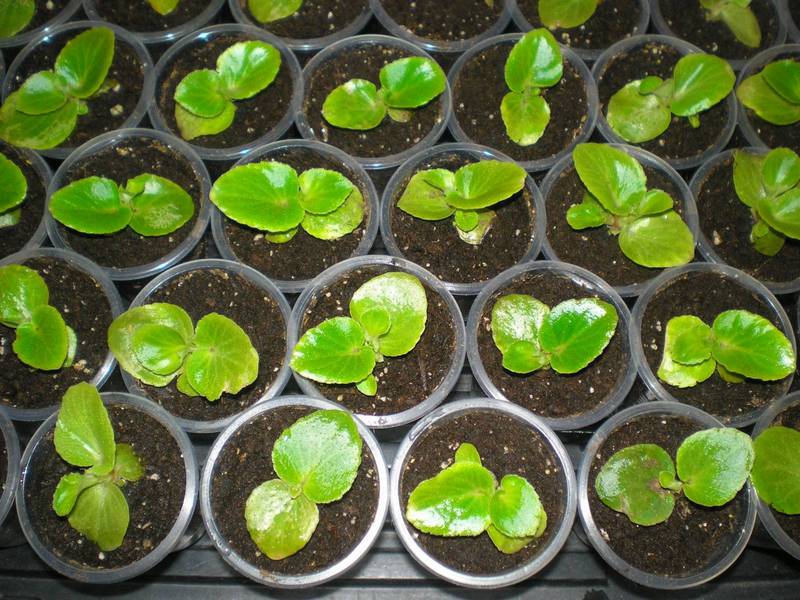

Now it is necessary to ventilate the crops by opening the glass for several hours. And after a while, when the sprouts are more noticeable, they are of a bright green color, the glass is removed completely.
Now, when begonia seedlings begin to develop, they need light, so they have to illuminate with lamps in the morning and in the evening so that the daylight hours for them are at least 14-16 hours.
Advice! You need to water only to the bottom. How to do it? Spray water from a spray bottle onto the inner walls of the tray. Water will slide down along them. The main thing is not to overflow! The soil should not be wet or dry in order to avoid the dangerous "black leg" that crops are exposed to during this period.

